The Burrow

Looking for a new car? There are more than 50 brands and 370 individual models currently on sale in Australia to choose from – with even more on the horizon.1
But with so many choices available, which models are the right fit for motorists?
As car insurance comparison experts, we surveyed more than 3,000 people across Australia, the United States, and Canada to find out consumers’ preferences and determine the most suitable new car models for each country.
To do this, we looked at the most important features cited by participants – fuel efficiency and safety considerations – alongside the most preferred body types and price ranges to calculate a suitability index score for top-selling models in each nation.
Here’s what we found.
The Toyota Corolla Cross Hybrid topped the best new cars index.
In a sign of the times, the Corolla Cross satisfied Australians preference for SUVs, while the AU$36,480 before on-road costs starting price was within the second-most preferred price bracket.
The low 4.3L/100km claimed combined fuel consumption for the petrol-electric hybrid SUV was also among the lowest out of all popular new cars studied.
It achieved the full five-star safety rating by the Australasian New Car Assessment Program (ANCAP) under 2022 criteria.
The full-electric BYD Atto 3 was named the second-most suitable new car for Australians.
The small SUV is priced from AU$44,499 before on-road costs (as at the time of publication), which was within the third-most preferred price bracket.
Australians said ‘fuel efficiency’ was the most important feature to them, with the Atto 3 having a 16.0kWh/100km claimed energy consumption (or a low 1.8L/100km when converted to fuel metrics).
The Chinese electric SUV also scored five stars by ANCAP in 2022.
The Toyota Corolla placed third in the best new cars for Australians index.
Available in both hatchback and sedan body styles, a higher proportion of Australians preferred the latter with it starting from AU$32,320 before on-road costs, which is within the second-cheapest price bracket.
The small passenger hybrid car had a relatively low 3.9L/100km claimed fuel consumption and obtained a five-star ANCAP safety rating in 2018.
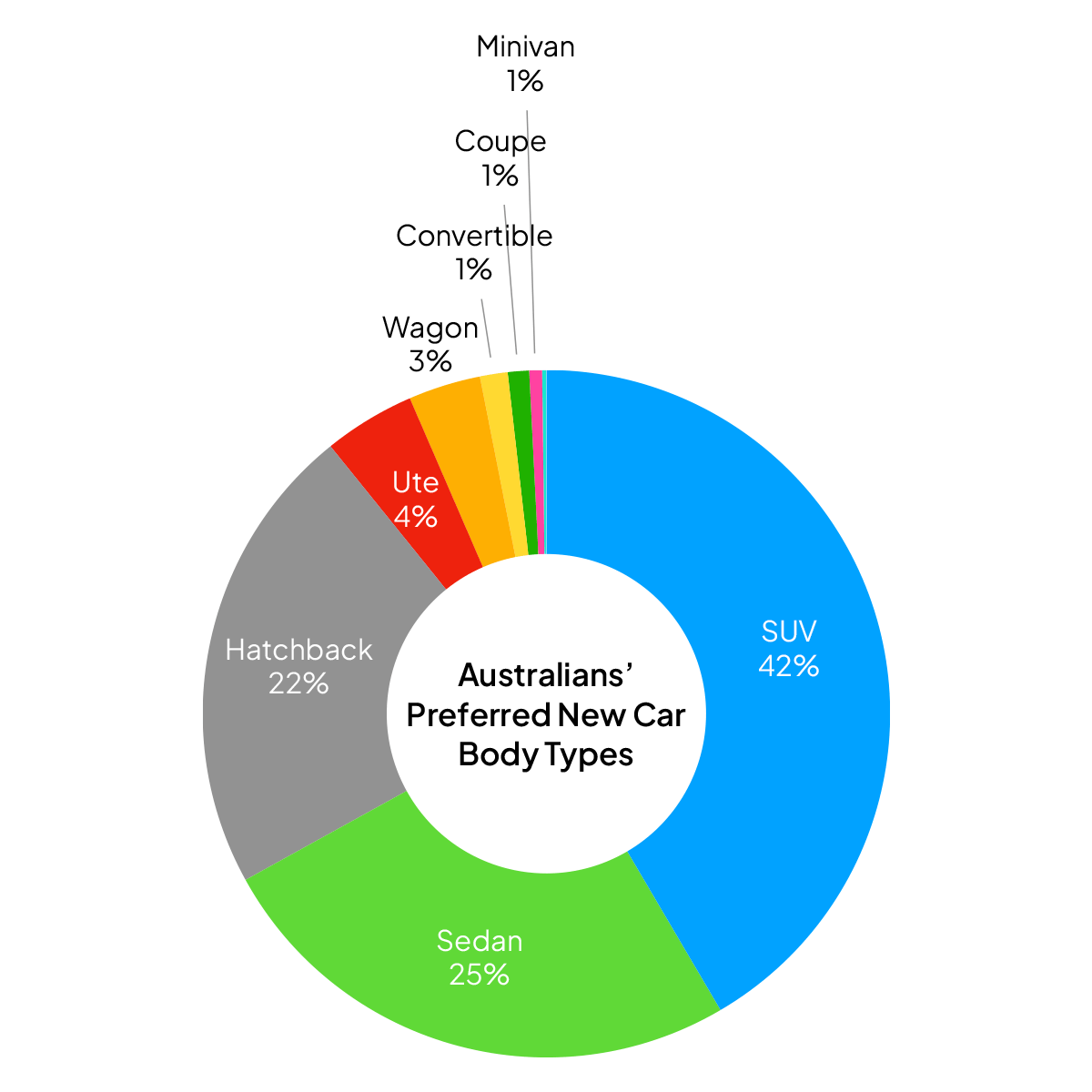
Figures were rounded to the nearest whole number
Following changing consumer preferences, Australians wanted to buy an SUV the most (41.5%).
This was followed by sedans (25.4%), which just overtook hatchbacks (22.2%). Despite the popularity of utes – driven by commercial fleet sales – only a small proportion of respondents actually preferred owning one (4.3%).
Australians also preferred wagons (3.4%) over people mover vans (0.6%).
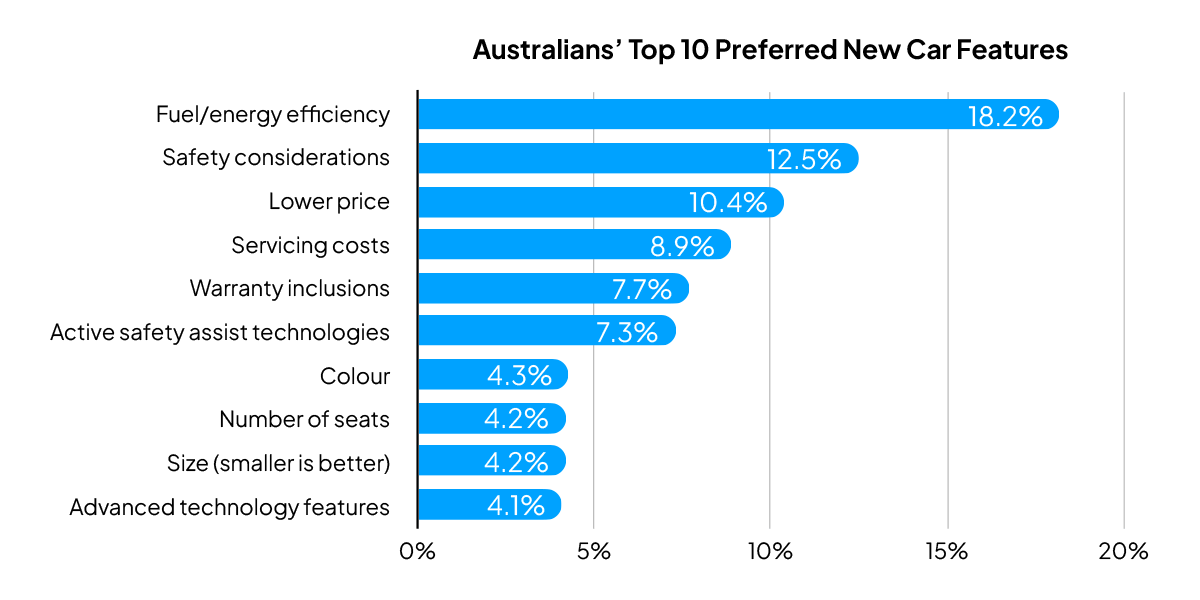
Figures were rounded to the nearest one decimal place
Australians prioritised fuel efficiency (18.2%), safety (12.5%), and a lower price (10.4%) when purchasing a new car – in line with Americans and Canadians.
Ownership considerations including servicing costs (8.9%) and warranty (7.7%) were also among the top, alongside active safety assistance features (7.3%).
| Rank | Make & Model | Index Score (out of 10) |
|---|---|---|
| 1 | Toyota Corolla Cross | 7.81 |
| 2 | BYD Atto 3 | 7.71 |
| 3 | Toyota Corolla | 7.66 |
| 4 | Toyota Camry | 7.61 |
| 5 | BYD Seal | 7.57 |
| 6 | Nissan Qashqai | 7.56 |
| 7 | Tesla Model Y | 7.52 |
| 8 | Toyota RAV4 | 7.51 |
| 9 | Mazda CX-30 | 7.45 |
| Kia Seltos | ||
| 10 | Mazda 3 | 7.41 |
The Honda Civic was named the most suitable new car for Americans.
It topped the index thanks to its sedan body type – which was second-most preferred by participants over the hatchback – alongside a low starting purchase cost, from US$25,345 according to the manufacturer’s suggested retail price (MSRP).
This was combined with good 36mpg claimed fuel efficiency on the combined cycle and the full five-star safety rating from the National Highway Traffic Safety Administration (NHTSA).
The Tesla Model Y electric SUV placed second in the best new cars index for Americans.
Crossover SUVs were most preferred by participants, with the US$44,380 starting MSRP being within the third-most affordable price bracket for Americans.
The Model Y was the best vehicle for ‘fuel efficiency’ with a claimed 120mpg consumption on the combined cycle, according to the United States Environmental Protection Agency (EPA). It also achieved the full five-star safety rating by NHTSA.
The Toyota Corolla compact car was found to be the third best option for new car buyers in the USA.
Available in hatchback and sedan forms, the latter was more preferred with a low US$23,145 base MSRP.
The 35mpg claim for the petrol-only engine was also among the best for fuel efficiency, while NHTSA also awarded the small car the full five-star safety rating.
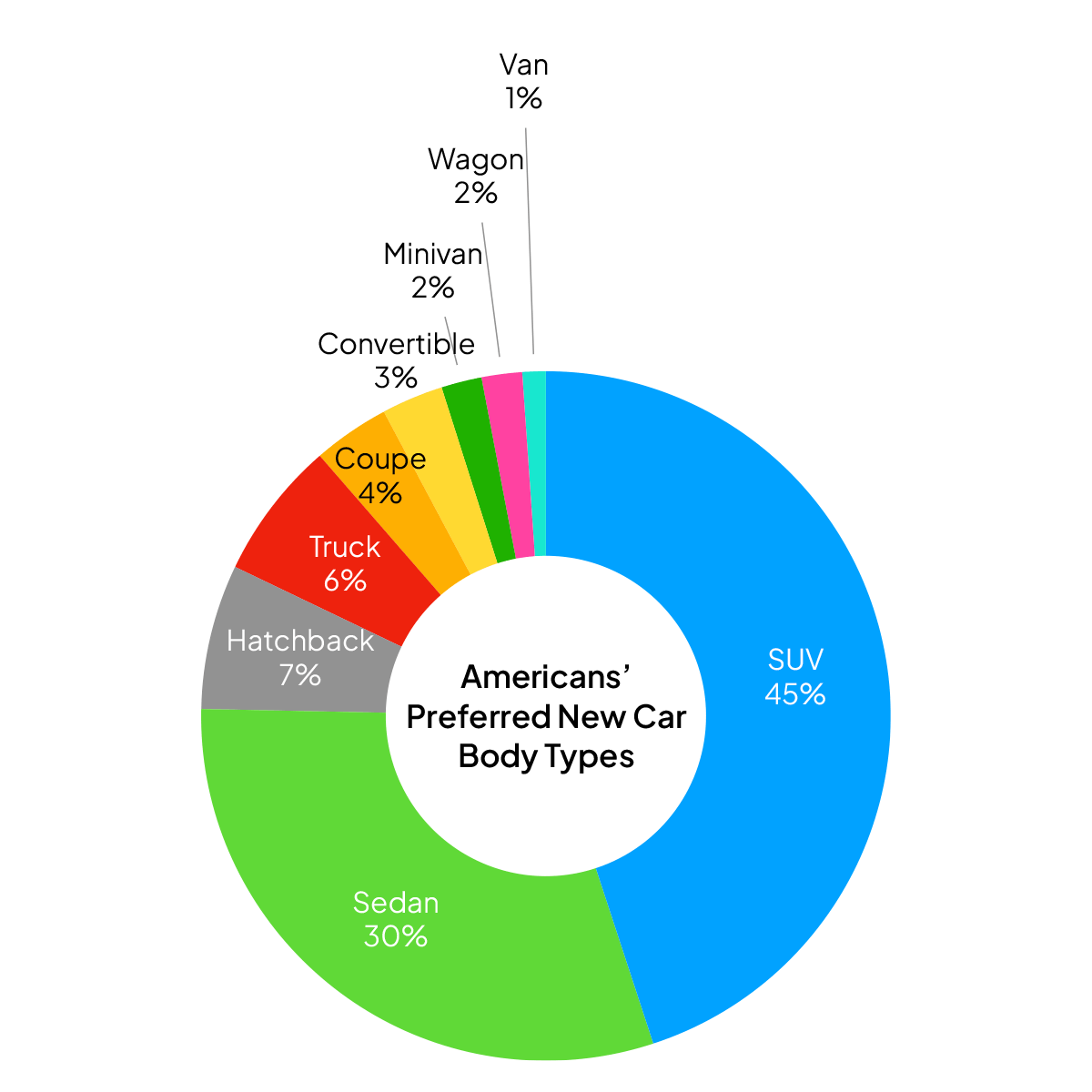
Figures were rounded to the nearest whole number
Americans most preferred SUVs (45.0%) and sedans (30.4%).
However, the proportion of respondents who chose hatchbacks (6.8%) and trucks (6.5%) were comparatively less.
Coupes (3.6%) were favoured more than convertibles (2.9%), while minivans and wagons have fallen out of fashion.
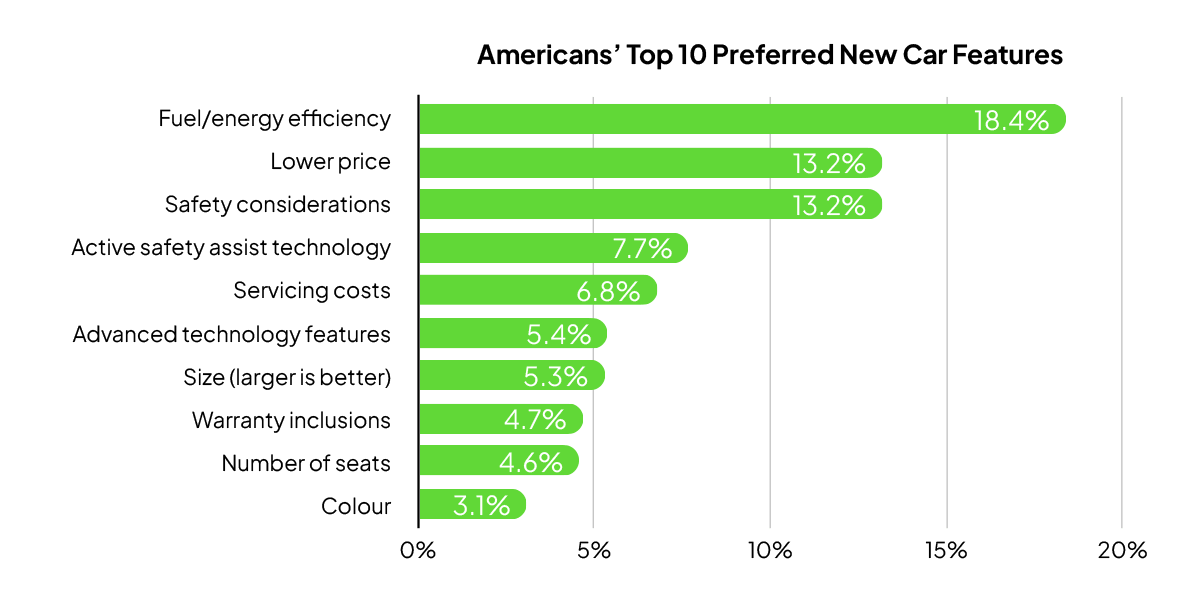
Figures were rounded to the nearest one decimal place
Americans preferred fuel efficiency (18.4%), a lower price (13.2%), and safety (13.2%) as the main factors for buying a new car.
Participants also cited other attractive car traits, including active safety assist technologies (7.7%), servicing costs (6.8%), and advanced technology features such as connected services (5.4%).
Americans wanted a larger-sized vehicle, whereas Australians preferred smaller cars.
| Rank | Make & Model | Index Score (out of 10) |
|---|---|---|
| 1 | Honda Civic | 7.56 |
| 2 | Tesla Model Y | 7.52 |
| 3 | Toyota Corolla | 7.46 |
| 4 | Nissan Sentra | 7.35 |
| 5 | Nissan Rogue | 7.25 |
| 6 | Toyota Camry | 7.15 |
| Honda Accord | ||
| 7 | Subaru Crosstrek | 6.87 |
| 8 | Toyota RAV4 | 6.83 |
| Honda CR-V | ||
| 9 | Chevrolet Trax | 6.56 |
| Honda HR-V | ||
| 10 | Kia Sportage | 6.35 |
The Honda Civic and Toyota Corolla tied as the best new cars for Canadian drivers.
Both Japanese compact cars are available as sedans, the second-most preferred body type, with low price tags: CA$27,540 starting MSRP for the Civic and CA$23,490 MSRP for the Corolla.
Fuel efficiency is rated at 6.7L/100km for both models, according to Government of Canada data, and both scored the full five-star safety rating by NHTSA.
The Hyundai Elantra was ranked the second most suitable new car for Canadians.
The sedan boasts a low CA$21,999 base MSRP, but 6.8L/100km claimed fuel consumption on the combined cycle.
The South Korean badged sedan has a five-star NHTSA safety score.
The Nissan Rogue was named the third best new car for buyers in Canada.
The SUV body style satisfies the tastes of Canadians, with a low CA$33,998 starting MSRP, and respectable 7.2L/100km claimed fuel economy.
The family SUV has obtained a five-star NHTSA safety score.
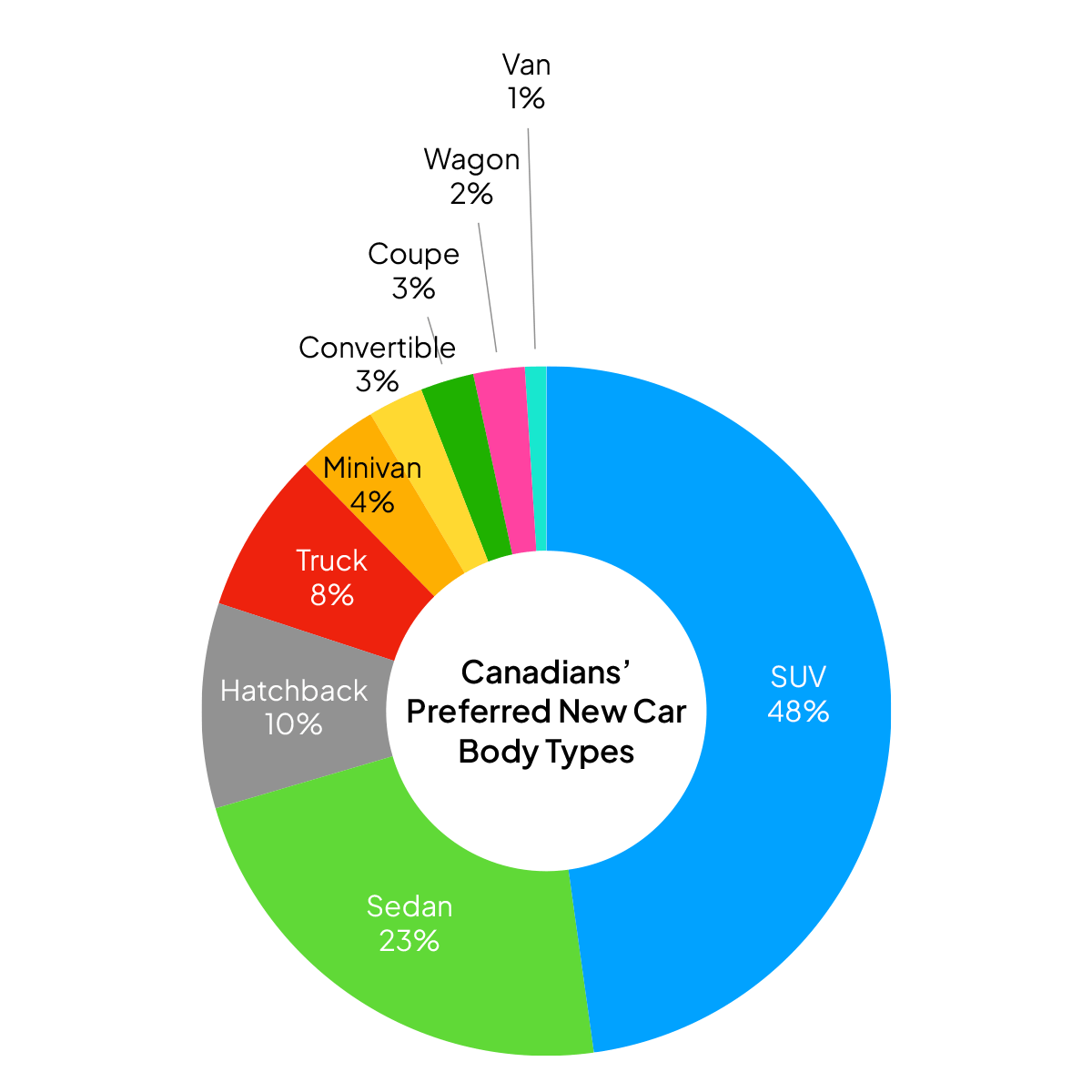
Figures were rounded to the nearest whole number
Most Canadians preferred the SUV body style (47.7%), followed by sedans (22.6%).
A smaller proportion of participants favoured hatchbacks (9.6%) and trucks (7.6%).
Meanwhile, minivans (3.8%) were preferred over wagons (2.4%), and convertibles (2.6%) over coupes (2.5%).
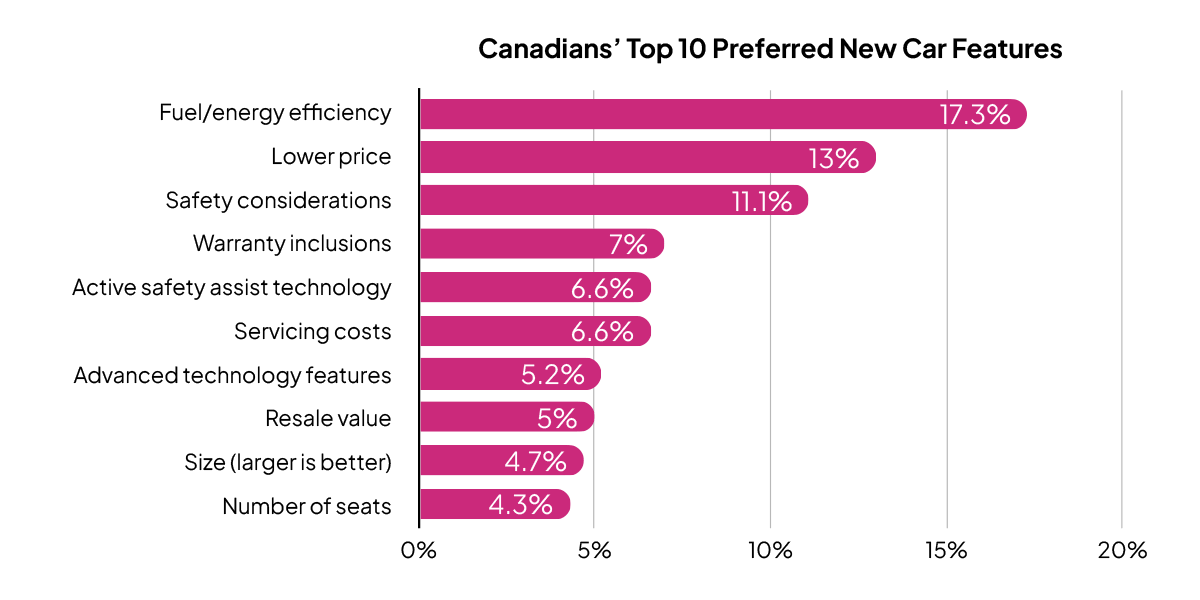
Figures were rounded to the nearest one decimal place
Canadians prioritised fuel efficiency (17.3%), a lower purchase price (13.0%), and safety (11.1%) when it comes to buying a new car.
Ownership considerations including warranty (7.0%) and servicing costs (6.6%) were also factors, alongside active safety assist systems (6.6%).
| Rank | Make & Model | Index Score (out of 10) |
|---|---|---|
| 1 | Honda Civic | 7.97 |
| Toyota Corolla | ||
| 2 | Hyundai Elantra | 7.61 |
| 3 | Nissan Rogue | 7.43 |
| 4 | Toyota Camry | 7.00 |
| 5 | Subaru Crosstrek | 6.97 |
| 6 | Kia Forte | 6.89 |
| Honda CR-V | ||
| 7 | Hyundai Kona | 6.79 |
| 8 | Toyota RAV4 | 6.54 |
| 9 | Chevrolet Colorado | 5.43 |
| 10 | Chevrolet Silverado 1500 | 5.36 |
Australians, Americans and Canadians surveyed had fairly similar priorities when it comes to buying a new car. But, Compare the Market’s Executive General Manager of General Insurance, Adrian Taylor, said car insurance should also be a key consideration.
“If you’re looking for a new car, you should protect it too,” Mr Taylor said.
“Comprehensive car insurance provides a level of cover in the event of an accident, but prices could vary widely between each insurer, vehicle model, and other risk-based factors.
“That’s why it pays to compare your options to look for a policy that suits your needs and budget – before you sign the dotted line for your new car.”
Always read the Product Disclosure Statement (PDS) and Target Market Determination (TMD) to check for the inclusions, limits and restrictions before purchasing.
Compare the Market commissioned PureProfile to survey a nationally representative sample of 1,005 Australians, 1,005 Americans, and 1,005 Canadians in July 2024.
The best-selling new car models (entry-level variants only) were studied in each market and then synthesised with survey results to produce an index.
The index included the following metrics:
Additionally, the most important features cited from participants in each country was also included as factors and then indexed. This included:
These four indexed factors were then averaged to produce an overall index score out of 10. A higher score is better.